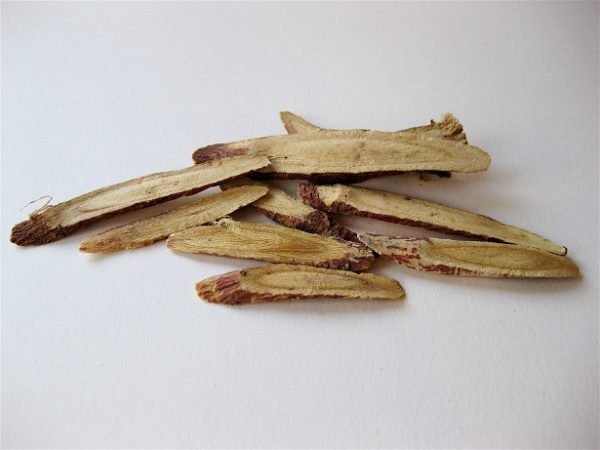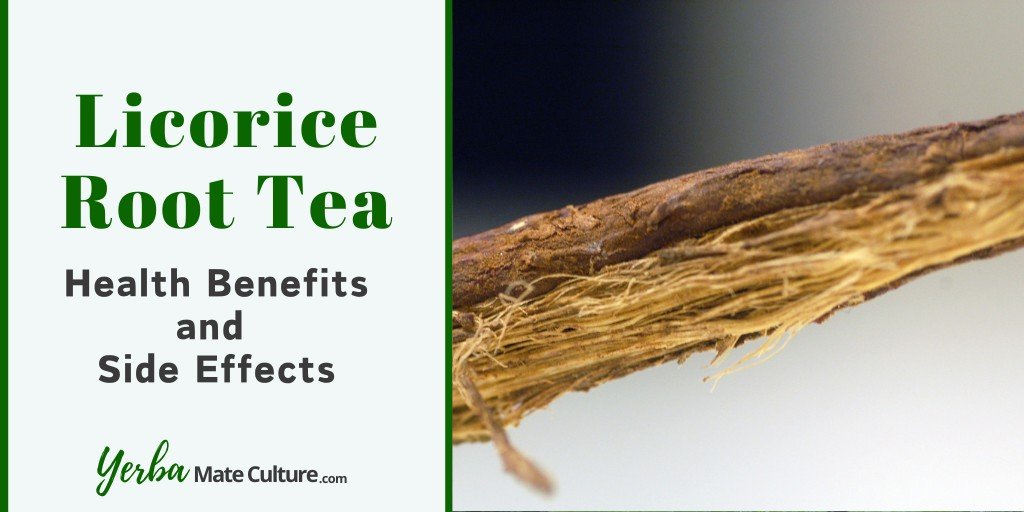Most people are familiar with licorice because it is used commonly as a flavoring for candies. Licorice root can also be used to brew a naturally sweet tea with many health benefits.
Continue reading and learn more about this delicious herbal beverage that has been used as a natural remedy since the time of ancient Egyptians.

What is Licorice Root Tea?
Licorice tea is prepared by brewing the root of the licorice plant (Glycyrrhiza glabra) or the Chinese licorice (Glycyrrhiza uralensis).

The licorice plant is a perennial legume that natively grows in southern Europe, the Middle East, and some parts of Asia. It is related to fennel and anise, which contain similar flavors and can also be used for making tea.
History of Medical Use
In the east, the healing properties of licorice tea were discovered thousands of years ago. The Code of Hammurabi, written almost 4,000 years ago, mentions the therapeutic effects of licorice root.
Today it is one of the most important natural remedies used in traditional Chinese and Indian medicine.
Licorice Root Tea Health Benefits
The use of licorice root is common in traditional medicine, especially in the areas where it grows naturally. Its many health benefits have been known for a very long time and have later been confirmed by research.
Licorice root contains many beneficial compounds such as antioxidants, flavonoids, glycosides, and sterols and it’s also one of the most important components of Matula tea.
1. Digestion
Licorice root tea has often been used as a remedy for digestive problems including heartburn, upset stomach, indigestion, and bloating.
Licorice’s use as a digestive aid is mainly attributed to glycyrrhizic acid, which has anti-inflammatory and immune-boosting properties. Recent research supports the use of licorice in treating many digestive conditions.
A randomized, double-blind, placebo-controlled study published in Evidence-Based Complementary and Alternative Medicine found licorice to be an effective remedy for heartburn and indigestion. Another study indicates that licorice root can also help with protecting us against harmful bacteria such as H. pylori, which can cause ulcers and other intestinal problems.
2. Cough and Common Cold
Licorice tea is an excellent natural remedy for cough, common cold, and sore throat. It helps with creating a protective layer of mucus to soothe an irritated throat and bronchial tubes. In addition, the antibacterial and immune-boosting properties of licorice can help with getting rid of the bacteria and healing faster.
Research has confirmed the antitussive and expectorant capabilities of licorice. This means that licorice does not just soothe an irritated throat and prevent coughing but it also helps with ejecting the phlegm.
3. Skin Health
The antioxidants of licorice tea can help with maintaining healthy skin by eliminating free radicals that cause oxidative stress, which makes the skin look older. In addition, the antimicrobial qualities of licorice root help with eczema and other skin inflammations.
A study from 2010 found that the isoflavonoids of licorice root help with cleaning the skin and fighting against harmful bacteria.
4. Stress and Anxiety
The modern-day environment and its constant stimulus and demands can easily lead to stress and anxiety. This constant stress can cause adrenaline fatigue and many other problems.
A study published in Molecular and Cellular Endocrinology found that licorice can help our bodies regulate cortisol, the main stress hormone, more efficiently. This makes licorice root tea a potential aid for reducing the symptoms related to stress and anxiety.
5. Oral Health
Licorice root tea is also considered to be good for oral hygiene. Research indicates that some compounds found in licorice root have an antibacterial effect against several major oral pathogens.
Here is a short video that sums up the health benefits of licorice tea:
Precautions and Possible Side Effects of Licorice Tea
Licorice tea is generally considered safe when consumed in moderate amounts. If large amounts of licorice tea are consumed for an extended period of time, it can cause side effects such as high blood pressure or low potassium levels in the blood.
The World Health Organization (WHO) and the European Scientific Committee of Food (SCF) recommend that no more than 100 mg of glycyrrhizin should be consumed per day. A review of 33 brands found that the mean glycyrrhizin content of licorice tea was 126 mg/L.
This means that consuming about 1 to 3 cups of licorice tea per day should be fine, but I would avoid frequently drinking more than that.
There are also a few other precautions to consider:
- Drug interactions: Persons who are on medication should consult their doctor before consuming licorice tea. Especially people who are using antidepressants or blood pressure medication should be careful with consuming it.
- Pregnancy: Women who are pregnant should not drink licorice tea as it can increase the risk of miscarriage. I would also not recommend drinking it if you are breastfeeding.
- Medical conditions: Persons with heart disease, kidney disease, or high blood pressure should be extra careful with licorice tea.
How to Make Licorice Root Tea?
Preparing a cup of sweet and tasty licorice root tea is quite easy. I often like to mix it with other ingredients. Go ahead and try different blends!
Here are the instructions for preparing licorice tea:
- Boil some water and add sliced or ground licorice root. You can use about one tablespoon of licorice root per one cup of water.
- Optional: Add some other ingredients such as ginger root, cinnamon, or peppermint leaves.
- Cover and let it steep for about 10 to 15 minutes.
- Pour into cups through a strainer.
Use one of our recommended glass tea kettles and you can observe the tea while its brewing. This helps you to decide when it’s ready, as the color starts to turn darker brown.

If you want to make things a bit easier, you can order some Pukka Peppermint & Licorice Tea. It is one of my all-time favorites for herbal infusions in tea bags!
More Benefits: Ginger, Licorice & Mint Tea
One of my favorite herbal teas is made by blending licorice root with fresh or dried ginger root and mint leaves. This combination is not only delicious, but it is also a very effective remedy for the common cold, cough, and sore throat.
In addition to all the health benefits of licorice that were discussed in this article, ginger can help with relieving irritation, ejecting mucus, and suppressing the cough while peppermint relieves the congestion and helps with getting rid of phlegm so you can recover faster.
This powerful herbal blend is also full of antioxidants and provides many health benefits from improving digestion to relieving headache and stress!
Licorice Root Tea FAQ
Why is licorice tea sweet?
Licorice root contains glycyrrhizin a compound that gives the tea its naturally sweet taste. This compound is also mainly responsible for the herb’s antioxidant, anti-inflammatory, and antimicrobial properties.
How many cups of licorice tea a day can I drink?
Depending on the strength of the tea, it is safe to consume about 1 to 3 cups of licorice root tea daily. Licorice contains glycyrrhizin and its consumption should be limited to 100 mg per day. If you exceed this amount the risk of side effects will increase.
Also, if you are pregnant, have a medical condition, or are using any kind of medication, consult your doctor before drinking licorice tea.
What herbs can I blend with licorice root to make tea?
Some of my favorite herbs to blend with licorice are peppermint and ginger but you can also try chamomile, fennel, and cinnamon bark.
Enjoy the Benefits of Licorice Tea!
I really like the taste of licorice tea, especially when it’s blended with other herbs, such as mint, fennel, or ginger. Licorice tea makes an excellent dessert, as it is naturally sweet and aids healthy digestion.
It is also one of the best teas for cough, and when I’m sick, I often drink it before going to bed. This helps with avoiding cough during the night, which promotes better sleep and faster recovery.
Go ahead, prepare some licorice root tea, and enjoy its taste and benefits!
You can also try blending it with other ingredients to find your favorite mix, or try some of the blends in this article: Best Licorice Tea Products and Where to Buy Them
I hope you found this article useful. You can also find information and recipes related to other herbal teas on this site. If you have any questions or comments, please post them below.
Enjoy your Licorice Tea!
-Joonas



Hi Joonas,
I love your website and your posts are very informative.
Your passion for the teas and nature is reflected in your writing.
I really learnt a lot about your post on Licorice Tea and never even knew it until I read your post.
I love the use of photos and media and your recipe using ginger and peppermint must taste yummie!
Thank you for caring enough and sharing these wonderful health beneficial tea products.
Rds
Vivian J Young
Hi Vivian,
Great to hear that like my website! I really hope that my site will help people with trying new herbal teas that can offer them experiences and help them with staying fit and healthy.
I know that licorice tea is something that not too many people have tried. The reason I wrote this article is to encourage more people to try it so they can experience how it tastes. Another good reason to keep some licorice tea in stock is that it is one of the best natural remedies for cough and stomach problems.
All the Best,
Joonas
This was awesome.
After so many years in fitness and cooking I can’t believe I hadn’t stumbled upon using licorice roots before.
I’ll do some more researching but I’m guessing this isn’t very popular yet?
I’m a huge ginger fan so I can definitely see the combination going together.
Thanks for your comment Lee.
I also think that for some reason licorice root tea is not very common. But I think herbal teas are becoming more popular and easily available and now you can sometimes find licorice tea (or a blend that contains it) in regular supermarkets.
-Joonas
Great post!
I have always liked the taste of licorice and enjoyed learning about it’s healthy benefits here!
For most people, licorice tea could be a positive boost in their lives. I like that it could help keep skin look younger because taking care of my skin is important.
The recipe looks simple too for this licorice tea and I look forward to trying it out soon.
Thanks for sharing this information!
Hi Jesse,
Thanks for commenting and good to hear that you found the article useful. I hope you will enjoy your licorice tea!
-Joonas